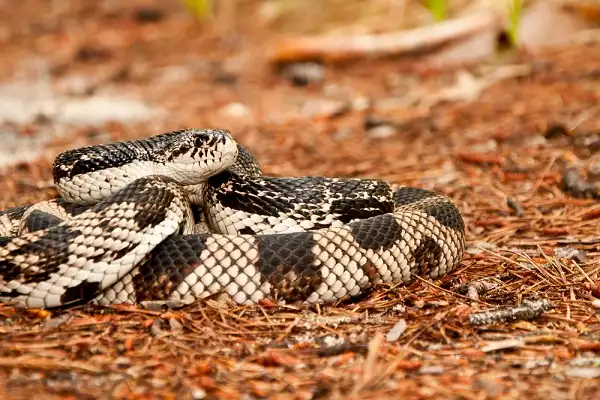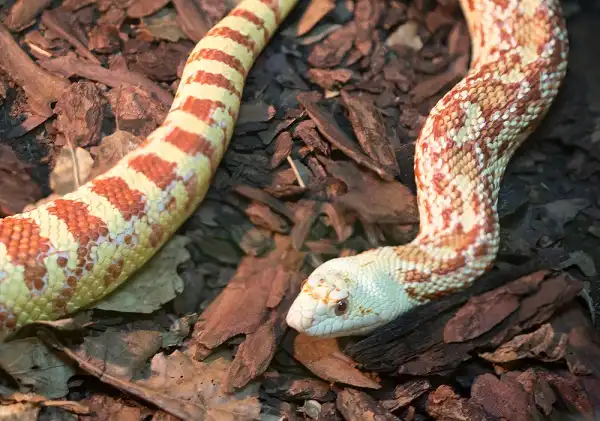Reptiles have long held a fascination among humans, and Pine Snakes are no exception. Endemic to the Southeastern United States. Their unique color markings of browns and tans mimic the pine needles they typically curl around or hide beneath—but don’t let their modest appearance fool you! This species has adapted well over time: they are often found along roadsides near wooded areas due to their excellent ability to cross an otherwise impassable barrier with ease (unlike other salamander family members). Now we’ll take a deeper look into what makes this snake so surprisingly charismatic.

Pine Snake Description
Pine Snakes, also known as Pituophis melanoleucus, is a species of nonvenomous snakes native to the Southeastern United States. They have an average length and feature distinct markings of tan and brown that look like pine needles – hence their name. They are constrictors, coiling around prey and suffocating them before consuming them whole. Pine Snakes typically live in wooded areas or along roadsides, where they can make use of the vegetation for cover. They have adapted to urbanization quite well, often seen slithering through yards, parks, and even under houses in search of food or shelter. Pine Snakes have long been admired by herpetologists for their fascinating habits and physical characteristics – which makes sense considering their impressive ability to survive in changing environments over time!
Pine Snake Habitat
Pine Snakes are adaptable, thriving in both wooded and urban areas. They prefer habitats that offer plenty of cover such as rock piles, logs, and leaf litter. They may also be found in open grasslands or pine barrens where they can hide beneath low shrubs or thick ground cover. In addition to these areas, Pine Snakes will often seek out basking sites near rocks or other large objects. This allows them to quickly escape into hiding when disturbed. Their range covers the Southeastern United States, including parts of Alabama, Florida, Georgia, Louisiana, Mississippi, North Carolina, and South Carolina. However, they have been known to inhabit the northeastern US states as well due to their excellent adaptive abilities. Pine Snakes also need moisture – particularly during the summer months – so it is important that they have access to sources of water such as ponds or streams. Due to their shy nature around humans, it is best that any potential habitat for Pine Snakes has minimal human interference.
Pine Snake Diet
Pine Snakes have a varied diet that primarily consists of small mammals like voles, mice, and chipmunks. They will also feed on birds, lizards, frogs, and other small creatures when available. Prey items are typically caught in the open and then constricted until crushed or suffocated before being consumed whole. Pine Snakes are opportunistic feeders and may take advantage of whatever they can find. When food is scarce, Pine Snakes will sometimes resort to scavenging for carrion or even preying upon other snakes. They may also feed on eggs laid by ground-nesting birds if given the opportunity. Additionally, they have been known to consume fruits such as apples when available – although this behavior is quite rare. Pine Snakes exhibit a slow but steady digestion process; they can go weeks without food before needing to replenish their energy reserves. This allows them to survive in less-than-ideal environments where prey is scarce and unpredictable.

Pine Snake Size
Pine Snakes range in size from 2-6 feet, with the average length being around 4 feet. The largest recorded Pine Snake was nearly 10 feet long! Pine Snakes have thick scales that allow them to move quickly over rough terrain and make tight turns when pursuing prey. Their muscular bodies give them great strength for constricting their victims; this helps them to subdue larger prey items that might be too difficult to swallow whole. All in all, Pine Snakes are powerful contenders in the wild!
Pine Snake Lifespan
Pine Snakes have a relatively long lifespan, with some individuals living up to 15 years in the wild. In captivity, they can live even longer – up to 20 years or more! These long-lived reptiles require plenty of space and a healthy diet in order to reach their full potential lifespan. On average, Pine Snakes begin reproducing at 3-5 years old and can produce several litters each year. The gestation period is between 8-10 months and the female will typically lay between 2-20 eggs depending on her size and age. The eggs take approximately 50-60 days to hatch and the young snakes are independent of birth. The cold winter temperatures in the south often force Pine Snakes into hibernation for several months; however, they usually remain active during mild winters or warmer climates. During this time, they will find shelter underground where they remain inactive until temperatures rise again in the springtime. Overall, Pine Snakes are fairly resilient creatures that are able to withstand a variety of environmental changes due to their excellent adaptive abilities. With proper care and habitat maintenance, these fascinating reptiles can be enjoyed for many generations.
Pine Snake Behavior
Pine Snakes are known to be solitary creatures, only gathering together in the winter months to hibernate. During the warmer months, they will spend most of their time alone, hunting and feeding on small mammals or other prey items. They typically move around during the day, basking in the sun and looking for food sources. At night, Pine Snakes will often hide under rocks or logs for protection from predators. Pine Snakes are also highly territorial; when threatened or disturbed they will coil up and hiss loudly as a warning signal. If provoked further, they may even strike out with their powerful jaws in an attempt to ward off potential threats. In terms of communication, Pine Snakes rely primarily on visual cues such as body language and posture to communicate with one another. They may also vibrate the ground with their bodies to alert other snakes of potential danger or attract potential mates during the breeding season. Additionally, they can release pheromones into the air that help them recognize each other’s presence within close proximity. Additionally, Pine Snakes have been known to exhibit behavioral adaptations in order to survive in more extreme climates. For example, when temperatures become too cold for them to remain active above ground they may bury themselves under several inches of soil and remain dormant until temperatures rise again. This behavior helps them regulate their body temperature and conserve energy during winter months when food is scarce.

Pine Snake Speed
Pine Snakes are surprisingly fast for their size and can reach speeds of up to 5 mph (8 km/h). They achieve this speed by rapidly undulating their bodies, moving their tail from side to side as they propel themselves forward. While this movement is not considered running, it allows them to quickly maneuver around obstacles, helping them to pursue prey or escape predators. Their powerful muscles allow them to change direction with ease; they can dart in any direction at a moment’s notice in order to outwit their prey or evade danger. Additionally, Pine Snakes are adept climbers and can scale rocky surfaces or trees without difficulty. Despite their impressive speed, Pine Snakes are not the fastest snakes in the world; some species such as the Black Mamba have been clocked at 10-12 mph (16-19 km/h). Nevertheless, Pine Snakes are still highly capable hunters and will use their speed and agility to track down food sources during the warmer months.
Pine Snake Hunting
Pine Snakes are opportunistic hunters and will consume a variety of small mammals, birds, reptiles, amphibians, and even fish. Their diet consists mainly of mice and voles; however, they also have been known to feed on amphibians such as frogs or salamanders when available. When it comes to hunting behavior, Pine Snakes are ambush predators; they will remain still until their prey is within striking distance before quickly lunging forward and grasping their target with their powerful jaws. They may then coil around the animal’s body in order to suffocate or constrict it before swallowing it whole. Pine Snakes have an excellent vision that helps them track down potential food sources from long distances. They will often lie in wait until they spot a potential meal before quickly striking out with their powerful jaws. Additionally, they have acute hearing and can detect the rustling of small animals from far away. This hunting method helps them to ambush unsuspecting prey, ensuring that they get their meal before it has a chance to escape.

Conclusion
Pine Snakes are fascinating creatures that have a variety of adaptations to help them survive in the wild. Their unique combination of speed and agility make them impressive hunters, while their ability to sense pheromones helps them communicate with each other when necessary. Due to their solitary nature, Pine Snakes prefer to hunt alone instead of relying on communal hunting techniques like some other snake species do; however, this has not stopped them from being successful predators. With their acute vision and hearing, as well as their powerful muscles, Pine Snakes can be formidable foes for potential prey or predators alike. While they may not be the fastest snakes in the world, they are certainly fast enough to help them outwit both prey and danger when necessary!
Frequently Asked Question


